Content for TS 38.413 Word version: 18.2.0
1…
4…
8…
8.2…
8.2.3…
8.3…
8.3.4…
8.4…
8.4.3…
8.5…
8.7…
8.8…
8.10…
8.12…
8.17…
9…
9.2…
9.2.2…
9.2.3…
9.2.4…
9.2.6…
9.2.7…
9.2.9…
9.2.11…
9.2.16…
9.2.17…
9.3…
9.3.1.21…
9.3.1.41…
9.3.1.61…
9.3.1.81…
9.3.1.101…
9.3.1.121…
9.3.1.141…
9.3.1.161…
9.3.1.181…
9.3.1.205…
9.3.1.222…
9.3.1.245…
9.3.2…
9.3.3…
9.3.3.21…
9.3.3.42…
9.3.4…
9.3.4.10…
9.3.5…
9.4…
9.4.4
9.4.5
9.4.6…
9.5…
10…
8.5 Paging Procedures
8.5.1 Paging
8.5.2 Multicast Group Paging
8.6 Transport of NAS Messages Procedures
8.6.1 Initial UE Message
8.6.2 Downlink NAS Transport
8.6.3 Uplink NAS Transport
8.6.4 NAS Non Delivery Indication
8.6.5 Reroute NAS Request
...
...
8.5 Paging Procedures p. 87
8.5.1 Paging p. 87
8.5.1.1 General p. 87
The purpose of the Paging procedure is to enable the AMF to page a UE in the specific NG-RAN node.
8.5.1.2 Successful Operation p. 88
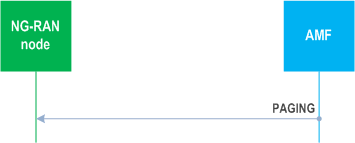
The AMF initiates the Paging procedure by sending the PAGING message to the NG-RAN node.
At the reception of the PAGING message, the NG-RAN node shall perform paging of the UE in cells which belong to tracking areas as indicated in the TAI List for Paging IE.
If the Paging DRX IE is included in the PAGING message, the NG-RAN node shall use it according to TS 38.304 and TS 36.304.
For each cell that belongs to any of the tracking areas indicated in the TAI List for Paging IE, the NG-RAN node shall generate one page on the radio interface.
If the Paging Priority IE is included in the PAGING message, the NG-RAN node may use it according to TS 23.501.
If the UE Radio Capability for Paging IE is included in the PAGING message, the NG-RAN node may use it to apply specific paging schemes.
If the Assistance Data for Recommended Cells IE is included in the Assistance Data for Paging IE it may be used, together with the Paging Attempt Information IE if also present, according to TS 38.300.
If the Next Paging Area Scope IE is included in the Paging Attempt Information IE it may be used for paging the UE according to TS 38.300.
If the Paging Origin IE is included in the PAGING message, the NG-RAN node shall transfer it to the UE according to TS 38.331 and TS 36.331.
If the NB-IoT Paging eDRX Information IE is included in the PAGING message, the NG-RAN node shall, if supported, use it according to TS 36.304. If the NB-IoT Paging Time Window IE is included in the NB-IoT Paging eDRX Information IE, the NG-RAN node shall take this information into account to determine the UE's paging occasion according to TS 36.304. The NG-RAN node should take into account the reception time of the PAGING message on the NG interface to determine when to page the UE.
If the NB-IoT Paging DRX IE is included in the PAGING message, the NG-RAN node shall use it according to TS 36.304.
If the Enhanced Coverage Restriction IE is included in the PAGING message, the NG-RAN node shall, if supported, use it as defined in TS 23.501.
If the Paging Assistance Data for CE Capable UE IE is included in the Assistance Data for Paging IE in the PAGING message, it may be used for paging the indicated CE capable UE, according to TS 36.300.
If the WUS Assistance Information IE is included in the PAGING message, the NG-RAN node shall, if supported, use it to determine the WUS group for the UE, as specified in TS 36.304.
If the E-UTRA Paging eDRX Information IE is included in the PAGING message, the NG-RAN node shall, if supported, use it according to TS 36.304. If the E-UTRA Paging Time Window IE is included in the E-UTRA Paging eDRX Information IE, the NG-RAN node shall take this information into account to determine the UE's paging occasion according to TS 36.304. The NG-RAN node should take into account the reception time of the PAGING message on the NGAP interface to determine when to page the UE.
If the CE-mode-B Restricted IE is included in the PAGING message and the Enhanced Coverage Restriction IE is not set to "restricted", the NG-RAN node shall, if supported, use it as defined in TS 23.501.
If the NPN Paging Assistance Information IE is included in the Assistance Data for Paging IE, the NG-RAN node may take it into account when determining the cells where paging will be performed.
If the NR Paging eDRX Information IE is included in the PAGING message, the NG-RAN node shall, if supported, use it according to TS 38.304 and TS 23.501. If the NR Paging Time Window IE is included in the NR Paging eDRX Information IE, the NG-RAN node shall take this information into account to determine the UE's paging occasion according to TS 38.304.
If the Paging Cause IE is included in the PAGING message, the NG-RAN node shall, if supported, transfer it to the UE according to TS 38.331 and TS 36.331.
If the PEIPS Assistance Information IE is included in the PAGING message, the NG-RAN node shall, if supported, use it for paging subgrouping of the UE, as specified in TS 38.300.
8.5.1.3 Abnormal Conditions p. 89
Void.
8.5.2 Multicast Group Paging |R17| p. 89
8.5.2.1 General p. 89
The purpose of the Multicast Group Paging procedure is to enable the AMF to notify CM-IDLE UEs which have joined a multicast MBS session about its activation. The procedure uses non-UE associated signalling.
8.5.2.2 Successful Operation p. 89
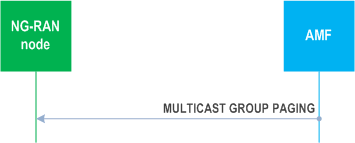
The AMF initiates the Multicast Group Paging procedure by sending the MULTICAST GROUP PAGING message to the NG-RAN node.
At the reception of the MULTICAST GROUP PAGING message, the NG-RAN node shall perform multicast group paging of the MBS session identified by the MBS Session ID IE utilising information provided by the AMF.
If the Paging DRX IE is included in the MULTICAST GROUP PAGING message, the NG-RAN node shall use it according to TS 38.304.
If the MBS Service Area IE is included in the MULTICAST GROUP PAGING message, the NG-RAN node shall take it into account during multicast group paging, as specified in TS 23.247.
If the UE Paging List IE is included in the MULTICAST GROUP PAGING message, the NG-RAN node shall, if supported, use it according to TS 38.304. If absent, the NG-RAN node shall perform multicast group paging of the MBS session in all paging occasions within at least one default paging cycle, as specified in TS 38.304.
8.5.2.3 Abnormal Conditions p. 90
Void.
8.6 Transport of NAS Messages Procedures p. 90
8.6.1 Initial UE Message p. 90
8.6.1.1 General p. 90
The Initial UE Message procedure is used when the NG-RAN node has received from the radio interface the first uplink NAS message to be forwarded to an AMF.
8.6.1.2 Successful Operation p. 90
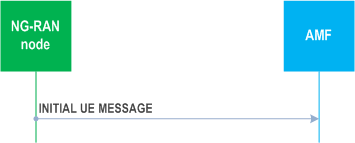
The NG-RAN node initiates the procedure by sending an INITIAL UE MESSAGE message to the AMF. The NG-RAN node shall allocate a unique RAN UE NGAP ID to be used for the UE and the NG-RAN node shall include this identity in the INITIAL UE MESSAGE message.
The NAS-PDU IE contains a UE - AMF message that is transferred without interpretation in the NG-RAN node.
In case of network sharing, the selected PLMN is indicated by the PLMN Identity IE within the TAI IE included in the INITIAL UE MESSAGE message, or by the Serving PLMN IE within the NR NTN TAI Information IE included in the same message for NTN.
When the NG-RAN node has received from the radio interface the 5G-S-TMSI IE, it shall include it in the INITIAL UE MESSAGE message.
If the AMF Set ID IE is included in the INITIAL UE MESSAGE message this indicates that the message is a rerouted message and the AMF shall, if supported, use the IE as described in TS 23.502.
If the UE Context Request IE is included in the INITIAL UE MESSAGE message the AMF shall trigger an Initial Context Setup procedure towards the NG-RAN node.
If the Allowed NSSAI IE is included in the INITIAL UE MESSAGE message the AMF shall use the IE as defined in TS 23.502.
If the Partially Allowed NSSAI IE is contained in the INITIAL UE MESSAGE message, the AMF shall, if supported, use the IE as defined in TS 23.502.
If the Source to Target AMF Information Reroute IE is included in the INITIAL UE MESSAGE message the AMF shall use the IE as defined in TS 23.502.
If the IAB Node Indication IE is included in the INITIAL UE MESSAGE message, the AMF shall consider that the message is related to an IAB node.
If the CE-mode-B Support Indicator IE is included in the INITIAL UE MESSAGE message and set to "supported", the AMF shall, if supported, use the extended NAS timer settings for the UE as specified in TS 23.501.
If the LTE-M indication IE is included in the INITIAL UE MESSAGE message the AMF shall, if supported, use it according to TS 23.501.
If the EDT Session IE set to "true" is included in the INITIAL UE MESSAGE message and the NG-RAN node is an ng-eNB, the AMF shall, if supported, consider that the message has been received as a result of an EDT session initiated by the UE.
If PNI-NPN related information within the NPN Access Information IE is received in the INITIAL UE MESSAGE message, the AMF shall, if supported, consider that the included information is associated to the cell via which the UE has sent the first NAS message, and to the PLMN Identity which is indicated within the TAI IE, and use the included information as specified in TS 23.501.
In case of network sharing for SNPNs, the selected SNPN is indicated within the User Location Information IE included in the INITIAL UE MESSAGE message by the PLMN Identity IE within the TAI IE and the NID IE.
If the RedCap Indication IE or the eRedCap Indication IE is included in the INITIAL UE MESSAGE message, the AMF shall, if supported, use it according to TS 23.501.
If the Mobile IAB Node Indication IE is included in the INITIAL UE MESSAGE message, the AMF shall consider that the message is related to a mobile IAB-node.
8.6.1.3 Abnormal Conditions p. 91
If the 5G-S-TMSI is not received by the AMF in the INITIAL UE MESSAGE message whereas expected, the AMF shall consider the procedure as failed.
If the Partially Allowed NSSAI IE is received in the INITIAL UE MESSAGE message and the total number of S-NSSAIs included in the Allowed NSSAI and Partially Allowed NSSAI exceeds eight, the AMF shall consider the procedure as failed.
If any of the S-NSSAI which is present in the Partially Allowed NSSAI IE is also present in the Allowed NSSAI IE, the AMF shall consider the procedure as failed.
8.6.2 Downlink NAS Transport p. 91
8.6.2.1 General p. 91
The Downlink NAS Transport procedure is used when the AMF only needs to send a NAS message transparently via the NG-RAN node to the UE, and a UE-associated logical NG-connection exists for the UE or the AMF has received the RAN UE NGAP ID IE in an INITIAL UE MESSAGE message or if the NG-RAN node has already initiated a UE-associated logical NG-connection by sending an INITIAL UE MESSAGE message via another NG interface instance.
8.6.2.2 Successful Operation p. 91
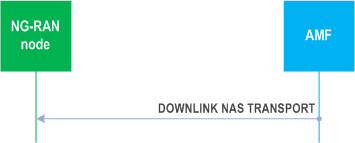
The AMF initiates the procedure by sending a DOWNLINK NAS TRANSPORT message to the NG-RAN node. If the UE-associated logical NG-connection is not established, the AMF shall allocate a unique AMF UE NGAP ID to be used for the UE and include that in the DOWNLINK NAS TRANSPORT message; by receiving the AMF UE NGAP ID IE in the DOWNLINK NAS TRANSPORT message, the NG-RAN node establishes the UE-associated logical NG-connection.
If the RAN Paging Priority IE is included in the DOWNLINK NAS TRANSPORT message, the NG-RAN node may use it to determine a priority for paging the UE in RRC_INACTIVE state.
The NAS-PDU IE contains an AMF - UE message that is transferred without interpretation in the NG-RAN node.
If the Mobility Restriction List IE is contained in the DOWNLINK NAS TRANSPORT message, the NG-RAN node shall overwrite any previously stored mobility restriction information in the UE context. The NG-RAN node shall use the information in the Mobility Restriction List IE if present in the DOWNLINK NAS TRANSPORT message to:
- determine a target for subsequent mobility action for which the NG-RAN node provides information about the target of the mobility action towards the UE;
- select a proper SCG during dual connectivity operation;
- assign proper RNA(s) for the UE when moving the UE to RRC_INACTIVE state.
The NG-RAN node shall use the AMF UE NGAP ID IE and RAN UE NGAP ID IE received in the DOWNLINK NAS TRANSPORT message as identification of the logical connection even if the RAN UE NGAP ID IE had been allocated in an INITIAL UE MESSAGE message sent over a different NG interface instance.
Interaction with the UE Radio Capability Info Indication procedure:
If the UE Capability Info Request IE set to "requested" is included in the DOWNLINK NAS TRANSPORT message, the NG-RAN node shall trigger the UE Radio Capability Info Indication procedure if UE capability related information was successfully retrieved from the UE.
8.6.2.3 Abnormal Conditions p. 93
If the Partially Allowed NSSAI IE is received in the DOWNLINK NAS TRANSPORT message and the total number of S-NSSAIs included in the Allowed NSSAI and Partially Allowed NSSAI exceeds eight, the NG-RAN node shall consider the procedure as failed.
If any of the S-NSSAI which is present in the Partially Allowed NSSAI IE is also present in the Allowed NSSAI IE, the NG-RAN node shall consider the procedure as failed.
8.6.3 Uplink NAS Transport p. 93
8.6.3.1 General p. 93
The Uplink NAS Transport procedure is used when the NG-RAN node has received from the radio interface a NAS message to be forwarded to the AMF to which a UE-associated logical NG-connection for the UE exists.
8.6.3.2 Successful Operation p. 93
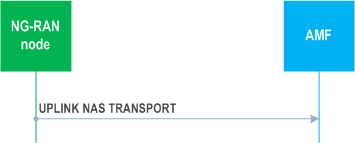
The NG-RAN node initiates the procedure by sending an UPLINK NAS TRANSPORT message to the AMF.
The NAS-PDU IE contains a UE - AMF message that is transferred without interpretation in the NG-RAN node.
8.6.3.3 Abnormal Conditions p. 94
Void.
8.6.4 NAS Non Delivery Indication p. 94
8.6.4.1 General p. 94
The NAS Non Delivery Indication procedure is used when the NG-RAN node decides not to start the delivery of a NAS message that has been received over a UE-associated logical NG-connection or the NG-RAN node is unable to ensure that the message has been received by the UE.
8.6.4.2 Successful Operation p. 94
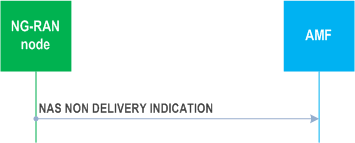
The NG-RAN node initiates the procedure by sending a NAS NON DELIVERY INDICATION message to the AMF. The NG-RAN node shall report the non-delivery of a NAS message by including the non-delivered NAS message within the NAS-PDU IE and an appropriate cause value within the Cause IE, e.g., "NG intra system handover triggered", "NG inter system handover triggered" or "Xn handover triggered".
8.6.4.3 Abnormal Conditions p. 94
Void.
8.6.5 Reroute NAS Request p. 94
8.6.5.1 General p. 94
The purpose of the Reroute NAS Request procedure is to enable the AMF to request for a rerouting of the INITIAL UE MESSAGE message to another AMF.
8.6.5.2 Successful Operation p. 94
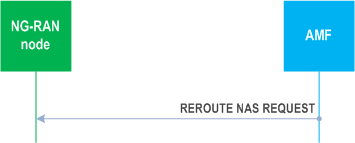
The AMF initiates the procedure by sending a REROUTE NAS REQUEST message to the NG-RAN node. The NG-RAN node shall, if supported, reroute the INITIAL UE MESSAGE message to an AMF indicated by the AMF Set ID IE as described in TS 23.501.
If the Allowed NSSAI IE is included in the REROUTE NAS REQUEST message, then the NG-RAN node shall propagate it in the rerouted INITIAL UE MESSAGE message as defined in TS 23.502.
If the Partially Allowed NSSAI IE is contained in the REROUTE NAS REQUEST message, the NG-RAN node shall, if supported, propagate it in the rerouted INITIAL UE MESSAGE message as defined in TS 23.502.
If the Source to Target AMF Information Reroute IE is included in the REROUTE NAS REQUEST message, then the NG-RAN node shall propagate it in the rerouted INITIAL UE MESSAGE message as defined in TS 23.502.
8.6.5.3 Abnormal Conditions p. 95
If the Partially Allowed NSSAI IE is received in the REROUTE NAS REQUEST message and the total number of S-NSSAIs included in the Allowed NSSAI and Partially Allowed NSSAI exceeds eight, the NG-RAN node shall consider the procedure as failed.
If any of the S-NSSAI which is present in the Partially Allowed NSSAI IE is also present in the Allowed NSSAI IE, the NG-RAN node shall consider the procedure as failed.